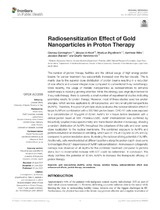| dc.contributor.author | Cunningham, C. | |
| dc.contributor.author | De Kock, M. | |
| dc.contributor.author | Engelbrecht, M. | |
| dc.contributor.author | Miles, X. | |
| dc.date.accessioned | 2021-09-21T18:36:40Z | |
| dc.date.available | 2021-09-21T18:36:40Z | |
| dc.date.issued | 2021 | |
| dc.identifier.citation | Cunningham, C., De Kock, M., Engelbrecht, M., Miles, X., Slabbert, J., & Vandevoorde, C. (2021). Radiosensitization effect of gold nanoparticles in proton therapy. Frontiers in Public Health, 9. https://doi.org/10.3389/fpubh.2021.699822 | en_US |
| dc.identifier.issn | 2296-2565 | |
| dc.identifier.uri | 10.3389/fpubh.2021.699822 | |
| dc.identifier.uri | http://hdl.handle.net/10566/6741 | |
| dc.description.abstract | The number of proton therapy facilities and the clinical usage of high energy proton beams for cancer treatment has substantially increased over the last decade. This is mainly due to the superior dose distribution of proton beams resulting in a reduction of side effects and a lower integral dose compared to conventional X-ray radiotherapy. More recently, the usage of metallic nanoparticles as radiosensitizers to enhance radiotherapy is receiving growing attention. While this strategy was originally intended for X-ray radiotherapy, there is currently a small number of experimental studies indicating promising results for proton therapy. However, most of these studies used low proton energies, which are less applicable to clinical practice; and very small gold nanoparticles (AuNPs). Therefore, this proof of principle study evaluates the radiosensitization effect of larger AuNPs in combination with a 200 MeV proton beam. CHO-K1 cells were exposed to a concentration of 10 μg/ml of 50 nm AuNPs for 4 hours before irradiation with a clinical proton beam at NRF iThemba LABS. AuNP internalization was confirmed by inductively coupled mass spectrometry and transmission electron microscopy, showing a random distribution of AuNPs throughout the cytoplasm of the cells and even some close localization to the nuclear membrane. The combined exposure to AuNPs and protons resulted in an increase in cell killing, which was 27.1% at 2 Gy and 43.8% at 6 Gy, compared to proton irradiation alone, illustrating the radiosensitizing potential of AuNPs. Additionally, cells were irradiated at different positions along the proton depth-dose curve to investigate the LET-dependence of AuNP radiosensitization. An increase in cytogenetic damage was observed at all depths for the combined treatment compared to protons alone, but no incremental increase with LET could be determined. In conclusion, this study confirms the potential of 50 nm AuNPs to increase the therapeutic efficacy of proton therapy. | en_US |
| dc.language.iso | en | en_US |
| dc.publisher | Frontiers Media | en_US |
| dc.subject | Radiosensitization | en_US |
| dc.subject | Nanoparticles | en_US |
| dc.subject | Proton Therapy | en_US |
| dc.subject | Effect | en_US |
| dc.title | Radiosensitization effect of gold nanoparticles in proton therapy | en_US |
| dc.type | Article | en_US |

